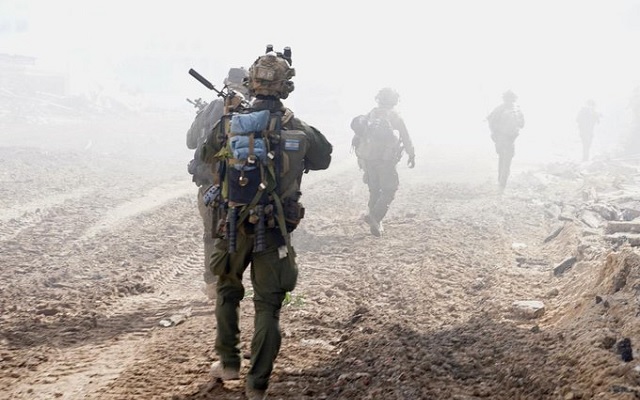
So, what is Benjamin Netanyahu’s plan?
COMMENT | IAN PARMETER | The Gaza war has now entered its eighth month and a resolution to the conflict still seems far off.
Israel claims to have killed 13,000 Hamas militants so far. If that figure is correct, one can assume the number of wounded or incapacitated militants is at least twice or maybe three times that number.
Prior to the war breaking out, Israel estimated there were around 30,000 Hamas fighters in Gaza. If this total can also be taken at face value, then Prime Minister Benjamin Netanyahu may be correct in arguing the removal of the last battalions in the southern city of Rafah would likely thwart the group’s ability to be a threat to Israel.
However, there are flaws in this reasoning. Israel has not explained how it calculates the number of militants the Israel Defense Forces (IDF) has killed. Given the chaotic conditions in Gaza, it’s not difficult to believe the 13,000 figure is merely an estimate based on the approximate number of military-aged men (18-40 years) among the 35,000 Palestinians killed in total.
In addition, if the remaining militants are hiding in tunnels beneath Rafah, as Netanyahu claims, what is to stop them from using the tunnel network to move north out of harm’s way? There is some evidence this is already occurring. The IDF and Israeli media say Hamas has regrouped in areas in central and northern Gaza that Israel claims to have “cleared” months ago.
More importantly, the IDF has been unable to locate and eliminate the two primary Hamas leaders – political leader Yahya Sinwar, who masterminded the October 7 attacks, and military leader Mohammed Deif. While these two remain at large, Israel cannot claim victory.
On top of that, Israel has not succeeded in rescuing the remaining hostages held by Hamas. Only three of the approximately 240 hostages seized by Hamas on October 7 have been freed by military action. Just over 100 other hostages have been released through negotiations and unilateral action by Hamas.
And international anger over Israel’s conduct of the war is growing exponentially, as demonstrated by the growing university sit-ins around the world and even the loud booing directed at Israel’s entrant in the Eurovision song contest.
U.S. President Joe Biden also initially held back a delivery of heavy-duty munitions to Israel due to Netanyahu’s decision to press ahead with the Rafah assault. However, this is symbolic. The Biden administration is still moving forward with US$1 billion (A$1.5 billion) in new weapons deals for Israel, as reported by the Wall Street Journal.
Although Hamas has not given reasons for its shocking attack that started the current war, it’s reasonable to assume they were along the following lines:
• to get the Palestinian cause to the top of the Middle East agenda at a time when Saudi Arabia was on the verge of reaching a peace agreement with Israel
• to draw international attention to the appalling conditions in Gaza, which has been described as the world’s largest open-air prison
• to stoke Israel’s anger to such an extent, it responds with excessive force and draws widespread international criticism.
On this logic, Hamas set a trap for Israel, and Israel walked into it.
Given the current situation, with Netanyahu far from achieving his stated aims in the war and international criticism only getting worse, where does this leave Netanyahu? He’s facing pressure from three sides, with no good options.
First, he leads the most right-wing government in Israeli history. The more extreme among his coalition partners, particularly Finance Minister Bezalel Smotrich and Security Minister Itamar Ben-Gvir, have been clear they will walk out of the government and cause fresh elections if Netanyahu agrees to a lengthy ceasefire.
With 71% of Israelis wanting Netanyahu to resign, according to a recent poll, he would almost certainly lose an election held any time soon.
Second, the families and supporters of the remaining 130 or so hostages believed to be held by Hamas – of whom Israeli intelligence estimates about a quarter have died – are applying relentless pressure on Netanyahu to accept a ceasefire in return for their release.
And third, Biden, his chief ally, wants the war over as quickly as possible due to the upcoming U.S. presidential election. Biden is well aware of the risk that progressives and Arab Americans may not turn out to vote in November – handing the presidency to Donald Trump by default.
Withholding the munitions shipment earlier this month was just one of many signals Biden has sent to Netanyahu that his patience is wearing thin.
The tragic irony is that negotiations led by Egypt and Qatar for a ceasefire and release of hostages have come remarkably close to success. The failure to close the deal has led The Economist to ask if Netanyahu actually wants to accept a deal.
The longer the war has dragged on, the more it has highlighted that Israel, which has been under Netanyahu’s almost continuous rule since 2009, has no long-term strategy for living side-by-side with its Palestinian neighbours.
Even if a ceasefire could be agreed to, Netanyahu’s government hasn’t articulated a plan for the “day after”. Already, this lack of a plan is creating a dangerous power vacuum in northern Gaza that has been filled by gangs, clans and criminals.
The U.S. deputy secretary of state, Kurt Campbell, this week warned the current situation is reminiscent of what the U.S. faced in Iraq and Afghanistan after invading in the wake of the September 11, 2001, terrorist attacks: […] after civilian populations had been moved and lots of violence […] the insurrections continue.
So, what is the plan for Gaza? Neither Israelis nor Palestinians would support the IDF reoccupying the strip for the long term.
Netanyahu has also made clear his government would not accept a reformed Palestinian Authority, which currently governs part of the West Bank, from taking control of Gaza. And Netanyahu’s preferred option – persuading non-aligned clan leaders to manage the strip on Israel’s behalf – is a recipe for corruption and score-settling between rival families.
Options involving outside forces from the region or the United Nations have also failed to gain traction.
Where does this leave the people of Gaza? As they flee from one conflict zone to another, Palestinian residents are losing hope. As one community leader in Rafah recently said, the war has changed everything but most of all there is now no security. There is nothing now for the weak. Only the strong can survive now.
****

Ian Parmeter is Research Scholar, Centre for Arab and Islamic Studies, Australian National University
Source: The Conversation
 The Independent Uganda: You get the Truth we Pay the Price
The Independent Uganda: You get the Truth we Pay the Price



